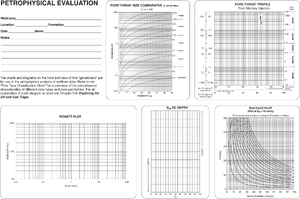Difference between revisions of "Midale seal capacity and trap type"
(Initial import) |
(figures got garbled) |
||
| Line 29: | Line 29: | ||
Therefore, any estimate of oil or gas column heights should be tested against all other information available. Column height and the [[buoyancy pressure]] it generates should make sense in context with shows of oil or gas, water saturations, trap closure, and pressure data. | Therefore, any estimate of oil or gas column heights should be tested against all other information available. Column height and the [[buoyancy pressure]] it generates should make sense in context with shows of oil or gas, water saturations, trap closure, and pressure data. | ||
| − | + | [[File:Seal_capacity_trap_type_fig1.png|thumb|{{figure number|1}}The charts and diagrams on the front and back of this “gameboard” are for use in the petrophysical analysis of wellbore data. Refer to the “Pore Type Classification Chart” for a summary of the petrophysical characteristics of different pore types and pore geometries. For an explanation of each diagram or chart see Chapter 9 in ''Exploring for Oil and Gas Traps''.]] | |
| − | + | [[File:Seal_capacity_trap_type_fig2.png|thumb|{{figure number|2}}The charts and diagrams on the front and back of this “gameboard” are for use in the petrophysical analysis of wellbore data. Refer to the “Pore Type Classification Chart” for a summary of the petrophysical characteristics of different pore types and pore geometries. For an explanation of each diagram or chart see Chapter 9 in ''Exploring for Oil and Gas Traps''.]] | |
| − | |||
| − | |||
==See also== | ==See also== | ||
| Line 40: | Line 38: | ||
* [[Middle lithofacies and distribution]] | * [[Middle lithofacies and distribution]] | ||
* [[Midale porosity, pore geometries, and petrophysics]] | * [[Midale porosity, pore geometries, and petrophysics]] | ||
| − | * [[Effect of pore geometry on Sw in | + | * [[Effect of pore geometry on Sw in Midale rocks]] |
* [[Weyburn seal capacity]] | * [[Weyburn seal capacity]] | ||
Revision as of 20:42, 4 February 2014
| Exploring for Oil and Gas Traps | |

| |
| Series | Treatise in Petroleum Geology |
|---|---|
| Part | Predicting the occurrence of oil and gas traps |
| Chapter | Predicting reservoir system quality and performance |
| Author | Dan J. Hartmann, Edward A. Beaumont |
| Link | Web page |
| Store | AAPG Store |
Significance of rbt for seal capacity
Midale Marly beds are universally accepted as being the top seal for this accumulation. They are essentially the same facies as the Midale Vuggy beds, analyzed here as a possible updip seal. This study shows the updip change in pore throat sizes could account for 280–890 ft (95–298 m) of oil column. The column height shown from producing wells at Weyburn and nearby Steelman fields is length::600 ft. We are left with two possible conclusions:
- If the estimate of oil column height using Rbt from the Winland r10 equation is correct, the Midale Marly beds do not have the capacity from their capillary properties to seal the column of oil shared by Weyburn and Steelman. Weyburn is a hydrodynamic trap or a combination hydrodynamic–stratigraphic trap.
- If the calculation of Rbt from the Winland r35 equation is correct, then the capillary properties of the Midale Marly beds could seal Weyburn field without hydronamics.
Representative sampling
This way of calculating seal capacity assumes that the core samples used are representative of the seal. Ideally, the rock samples should represent the seal at several geographic points. For instance, a stratigraphic trap may have variable seal capacity along the lateral seal. The best seal rocks might be located at the structurally highest point above a hydrocarbon column and might be capable of holding a 600-ft (180-m) oil column. Yet if the seal lying length::100 ft depth::(30 m) structurally downdip and laterally along the seal had seal capacity of length::200 ft depth::(60 m), then the total column could not exceed length::300 ft depth::(90 m).
Summary
As often happens in oil-field studies, this one did not yield a unique solution. This analysis is not sufficiently precise to answer the question of a capillary vs. hydrodynamic seal, but it does show the probability that more thorough quantitative work of the type illustrated would be definitive. Particularly helpful would be detailed analysis of r10 or r35 values of the updip Midale Vuggy beds.
Therefore, any estimate of oil or gas column heights should be tested against all other information available. Column height and the buoyancy pressure it generates should make sense in context with shows of oil or gas, water saturations, trap closure, and pressure data.


See also
- Evaluation of trap type
- Weyburn field location and trap problem
- Middle lithofacies and distribution
- Midale porosity, pore geometries, and petrophysics
- Effect of pore geometry on Sw in Midale rocks
- Weyburn seal capacity